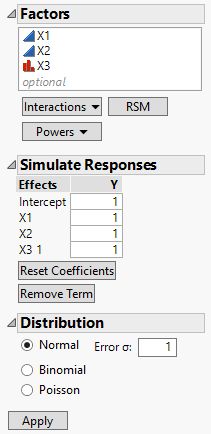Simulate Responses
When you click Make Table to create your definitive screening design table, the Simulate Responses option adds the following for each response to the design table:
• Random response values to the response column.
• A new a column containing a simulation model formula. The formula and values are based on a main effects model.
A Model window enables you to add and remove effects to define a model, specify parameter values, and select a response distribution for simulation. When you click Apply in the Model window, each column containing a simulation model formula is updated.
Control Window
Figure 8.10 shows the Model window for a design with two continuous factors (X1 and X2) and one two-level categorical factor (X3).
Figure 8.10 Simulate Responses Control Window
The window has three sections:
• Factors
• Simulate Responses
• Distribution
The initial Simulate Responses section shows terms for a main effects model with values of 1 for all coefficients. The Distribution section shows a Normal distribution with error standard deviation equal to 1. If you have set Anticipated Coefficients as part of Power Analysis under Design Evaluation in the DOE window, then the initial values in the Simulate Responses section are the values that you specified as Anticipated Coefficients and Anticipated RMSE (Error Std) in the Power Analysis section.
Factors
Add terms to the simulation model using the Factors section.
Interactions
Select factors in the list. Then select the interaction order from the Interactions menu. Those interactions are added to the list of Effects in the Simulate Responses section.
RSM
Adds all possible response surface terms to the list of Effects in the Simulate Responses section.
Powers
Select factors in the list. Then select the order from the Powers menu. Those powers are added to the list of Effects in the Simulate Responses section.
Simulate Responses
To specify a model for simulated values, do the following:
1. For each term in the list of Effects, enter coefficients for the linear model used to simulate the response values. These define a linear function, L(x, β) = x‘β. See the Simulate Responses section in Figure 8.10:
– The vector x consists of the terms that define the effects listed under Effects.
– The vector β is the vector of model coefficients that you specify under Y.
2. Under Distribution, select a response distribution.
3. Click Apply. A <Y> Simulated column containing simulated values and their formula is added to the design table, where Y is the name of the response column.
Reset coefficients
Sets all coefficients to 0.
Remove Term
Remove terms from the list of Effects. Select the effects to remove and click Remove Term. Note that you cannot remove main effects.
Distribution
Choose from one of the available distributions in the Simulate Responses window:
Normal
Simulates values from a normal distribution. Enter a value for Error σ, the standard deviation of the normal error distribution. If you have designated factors to have Changes of Hard in the Factors section, you can enter a value for Whole Plots σ, the whole plot error. If you have designated factors to have Changes of Hard and Very Hard, you can enter values for both the subplot and whole plot errors. When you click Apply, random values and a formula containing a random response vector based on the model are entered in the column <Y> Simulated.
Binomial
Simulates values from a binomial distribution. Enter a value for N, the number of trials. Random integer values are generated according to a binomial distribution based on N trials with probability of success 1/(1 + exp(-L(x, β))). When you click Apply, random values and their formula are entered in the column <Y> Simulated. A column called N Trials that contains the value N is also added to the data table.
Poisson
Simulates random integer values according to a Poisson distribution with parameter exp(L(x, β)). When you click Apply, random values and their formula are entered in the column <Y> Simulated.
Note: You can set a preference to simulate responses every time you click Make Table. To do so, select File > Preferences > Platforms > DOE. Select Simulate Responses.
